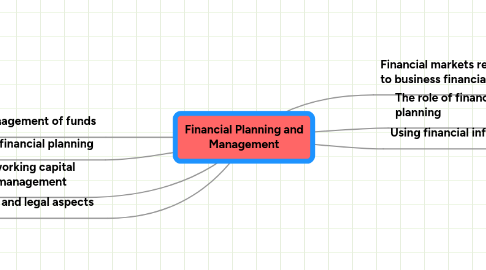Financial Planning and Management
por paul corkin


1. Management of funds
1.1. Sources of funds
1.1.1. Internal
1.1.2. External
1.2. Financial considerations - matching the terms and source of finance to business purpose and london
1.3. Comparison of debt and equity financing, including costs and benefits, risks, gearing / leverage
2. Effective working capital (liquidity) management
2.1. the working capital ratio
2.2. control of current assets - cash receivables, inventories
2.3. control of current liabilities - payables, loans, overdrafts
2.4. strategies for managing working capital - leasing, factoring, sale and lease back
3. Effective financial planning
3.1. effective cash flow management
3.1.1. cash flow statements
3.1.2. distribution of payments
3.1.3. discounts for early payments
3.2. effective profitability management
3.2.1. cost control - fixed and variable, cost centres, expense minimisation
3.2.2. revenue controls - sales objectives, sales mix, pricing policy
4. Ethical and legal aspects
4.1. audited accounts, inappropriate cut-off periods, misuse of funds
4.2. ASIC
4.3. Corporate raiders and asset stripping
5. The role of financial planning
5.1. Strategic role of financial managment
5.2. Objectives of financial management - liquidity, profitability, efficiency, growth, return on capital
5.3. The planning cycle
6. Financial markets relevant to business financial needs
6.1. Major participants in financial markets
6.1.1. Banks
6.1.2. Financial and insurance companies
6.1.3. Merchant banks
6.1.4. superannuation / mutual funds
6.1.5. companies
6.1.6. government
6.2. Role of the ASX
6.3. Overseas and domestic market influences and trends in financial markets and their implications for business financial needs
7. Using financial information
7.1. the accounting framework
7.1.1. financial statements
7.1.2. the accounting equation and relationships
7.2. types of financial ratios
7.2.1. liquidity - current ratio
7.2.2. solvency - gearing debt to equity
7.2.3. profitabiltity - gross profit ratio, net profit ratio, return on owners' equity
